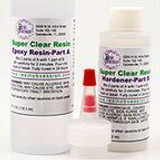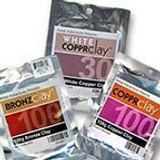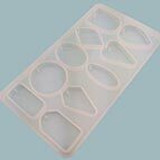-
 Artisan Concrete & Crystal Clay
Artisan Concrete & Crystal Clay
-
 Epoxy Resin, Casting Resin & UV Resin
Epoxy Resin, Casting Resin & UV Resin
-
 Kato Polyclay & Liquid Polyclay
Kato Polyclay & Liquid Polyclay
-
 Metal Clay Firing Supplies
Metal Clay Firing Supplies
-
 Metal Clays & Metal Clay Kits
Metal Clays & Metal Clay Kits
-
 Resin Dyes, Pigments & Metallic Powders
Resin Dyes, Pigments & Metallic Powders
-
 Resin Molds & Casting Supplies
Resin Molds & Casting Supplies
Pour on the charm by making handmade resin jewelry: These resins make it easy to create memory jewelry, custom focal pendants, mixed media designs and more. Choose from epoxy resin (aka doming resin), UV resin, and casting resin. You'll also find resin jewelry molds, pigments, dyes, glossy sealants, mixing cups and more supplies for your resin jewelry projects. Epoxy resins provide stronger adhesion, less shrinkage and tougher water resistance, once cured, than the polyester resins that are sometimes used to make jewelry.
Metal Clays remove many of the technical difficulties of metal work. Silver clay, bronze clay, and copper clay can be rolled, sculpted, stamped, sanded, burnished, filed, engraved, drilled and polished, as well as combined with glass, ceramics and more!
Polymer Clay is a fun and inexpensive sculpting medium to make everything from simple kawaii figurines to beautiful and complex cane art.
Tip: Be sure to keep tools and work surfaces used for precious metal clays (Art Clay Silver and PMC) separate from tools and work surfaces used for copper clays (COPPRclay) and bronze clays (BRONZclay). Otherwise, you are likely to get unintended results due to the mixing of different metal scraps.
Not sure how to get started? See our free free #resin and jewelry clay projects (no blinkin' ads and no login required).
Related Metal Clay and PolyClay Shaping Tools
Bench Blocks & Anvils | Mandrels | Wax Carving & Clay Shaping Tools
Molding Compounds | Burnishers | Brushes
Hobby Knives & Polymer Clay Blades | Cutting Mats
Jeweler's Files & Sanding Tools | Dapping and Shaping Dies | Templates
- Product
- Qty in Cart
- Quantity
- Price
- Subtotal
-

Blazer Micro Torch, Butane (Each)
$55.25See Related Products links (below) for similar items and additional jewelry-making supplies that are often used with this item. Questions? E-mail us for friendly, expert help! -

Kato Polyclay, 2oz - Violet (Each)
$1.98Polymer Clay Basics Polymer clays are man made modeling materials that, once heat cured, become permanent and will not return to their original state. All are composed of the same basic components: plasticizers, resins, fillers and colorants. ... -

Kato Polyclay, 2oz, Metallic - Silver (Each)
$1.98Polymer Clay Basics Polymer clays are man made modeling materials that, once heat cured, become permanent and will not return to their original state. All are composed of the same basic components: plasticizers, resins, fillers and colorants. ... -

Kato Polyclay, 2oz - Beige (Each)
$1.98Polymer Clay Basics Polymer clays are man made modeling materials that, once heat cured, become permanent and will not return to their original state. All are composed of the same basic components: plasticizers, resins, fillers and colorants. ... -

Mixing Cup, 1oz (10 Pieces)
$1.44See Related Products links (below) for similar items and additional jewelry-making supplies that are often used with this item. Questions? E-mail us for friendly, expert help! -

Silicone Resin Stud Earring Molds (pack)
$0.96See Related Products links (below) for similar items and additional jewelry-making supplies that are often used with this item. Questions? E-mail us for friendly, expert help! -


EasyCast 8oz Epoxy Kit - HZ* (Each)
Castin'Craft$12.95See Related Products links (below) for similar items and additional jewelry-making supplies that are often used with this item. Questions? E-mail us for friendly, expert help! -


Silicone Resin Pendants Mold (Each)
$3.71See Related Products links (below) for similar items and additional jewelry-making supplies that are often used with this item. Questions? E-mail us for friendly, expert help! -


Butane Micro Torch (Each)
$25.93New to torching? Don't worry! The packaging includes detailed instructions for lighting, flame adjustment, and refilling gas tank. This torch is incredibly easy to use, and has good safety features. See Related Products links (below) for similar items... -


Castin'Craft Jewelry Mold, 11 Gem Shapes (Each)
Castin'Craft$5.69See Related Products links (below) for similar items and additional jewelry-making supplies that are often used with this item. Questions? E-mail us for friendly, expert help! -

Ice Resin Squeegee (Each)
Ice Resin, Ranger$0.80See Related Products links (below) for similar items and additional jewelry-making supplies that are often used with this item. Questions? E-mail us for friendly, expert help! -

Kaowool Fiber Blanket, firing pad, 5x6x1" (Each)
$6.88See Related Products links (below) for similar items and additional jewelry-making supplies that are often used with this item. -

Castin'Craft Opaque Pigment - Black (Each)
Castin'Craft$6.97See Related Products links (below) for similar items and additional jewelry-making supplies that are often used with this item. Questions? E-mail us for friendly, expert help! -

Castin'Craft Opaque Pigment - Brown (Each)
Castin'Craft$4.84See Related Products links (below) for similar items and additional jewelry-making supplies that are often used with this item. Questions? E-mail us for friendly, expert help! -

Castin'Craft Opaque Pigment - Yellow (Each)
Castin'Craft$6.97See Related Products links (below) for similar items and additional jewelry-making supplies that are often used with this item. Questions? E-mail us for friendly, expert help! -


Castin'Craft Transparent Dye - Yellow (Each)
Castin'Craft$6.97See Related Products links (below) for similar items and additional jewelry-making supplies that are often used with this item. Questions? E-mail us for friendly, expert help! -

EURO TOOL Mesh Screens for Firing, 6" Square (Each)
EURO TOOL$3.16See Related Products links (below) for similar items and additional jewelry-making supplies that are often used with this item. -


Gold Alumilite Metallic Powder - Resin Colorant (Each)
Alumilite$8.70See Related Products links (below) for similar items and additional jewelry-making supplies that are often used with this item. Questions? E-mail us for friendly, expert help! -

Ice Resin Luster - Red Quartz (Each)
Ice Resin, Ranger$2.39Clean paintbrush with water after use.See Related Products links (below) for similar items and additional jewelry-making supplies that are often used with this item. Questions? E-mail us for friendly, expert help! -


Resin Bracelet Mold, Medium, 2 5/8" (Each)
$3.32See Related Products links (below) for similar items and additional jewelry-making supplies that are often used with this item. Questions? E-mail us for friendly, expert help! -


Silicone Resin Rings Mold (Each)
$5.06See Related Products links (below) for similar items and additional jewelry-making supplies that are often used with this item. Questions? E-mail us for friendly, expert help! -


Amazing Resin, 16oz (Each)
Alumilite$21.51See Related Products links (below) for similar items and additional jewelry-making supplies that are often used with this item. Questions? E-mail us for friendly, expert help! -

Craft Brush, Metal Handle (10 Pieces)
$2.88See Related Products links (below) for similar items and additional jewelry-making supplies that are often used with this item. Questions? E-mail us for friendly, expert help! -

EnviroTex Spray Sealer, 12.5oz - HZ* (Each)
$5.18For best results, use in a well-ventilated area, and carefully follow the directions on the back of the can.See Related Products links (below) for similar items and additional jewelry-making supplies that are often used with this item. -

Ice Resin Tint, Beryl - HZ* (Each)
Ice Resin, Ranger$3.59See Related Products links (below) for similar items and additional jewelry-making supplies that are often used with this item. Questions? E-mail us for friendly, expert help! -

Ice Resin Tint, Yarrow - HZ* (Each)
Ice Resin, Ranger$3.59See Related Products links (below) for similar items and additional jewelry-making supplies that are often used with this item. Questions? E-mail us for friendly, expert help! -

Mixing Set (Each)
$9.95See Related Products links (below) for similar items and additional jewelry-making supplies that are often used with this item. Questions? E-mail us for friendly, expert help! -

Stir Stick (10 Pieces)
$0.63See Related Products links (below) for similar items and additional jewelry-making supplies that are often used with this item. Questions? E-mail us for friendly, expert help!
